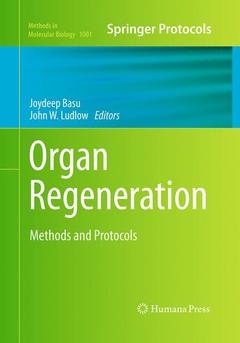Description
Organ Regeneration, Softcover reprint of the original 1st ed. 2013
Methods and Protocols
Methods in Molecular Biology Series, Vol. 1001
Coordinators: basu joydeep, Ludlow John W
Language: English
Subject for Organ Regeneration:
Publication date: 08-2016
Support: Print on demand
Publication date: 03-2013
377 p. · 17.8x25.4 cm · Hardback
Description
/li>Contents
/li>Comment
/li>
Tissue engineering and regenerative medicine represents a wide array of cell, biomaterial and cell/biomaterial based approaches focusing on the repair, augmentation, and regeneration of diseases tissues and organs. Organ Regeneration: Methods and Protocols has been assembled in response to the growing interest in organ and tissue regeneration as a means to treat disease. Topics cover methods such as isolation and characterization of cells from selected soft tissues and solid organs, preparation and evaluation of natural and synthetic biomaterial scaffolding, implantation of regenerative constructs within experimental animals, and evaluation of regenerative outcomes by molecular and histological methodologies. Written in the successful Methods in Molecular BiologyTMseries format, chapters include introductions to their respective topics, lists of the necessary materials and reagents, step-by-step, readily reproducible protocols, and notes on troubleshooting and avoiding known pitfalls.
Authoritative and easily accessible, Organ Regeneration: Methods and Protocols serves as a detailed guide to aid newcomers and seasoned veterans in their developmental and experimental work in tissue engineering and regenerative medicine.
Isolation and Characterization of Human Adipose-Derived Stem Cells for Use in Tissue Engineering.- Isolation of Smooth Muscle Cells from Bladder for Generation of Engineered Urologic Organs.- Isolation of Urothelial Cells from Bladder Tissue.- Isolation of Pulsatile Cell Bodies from Esophageal Tissue.- Cell Isolation Through Whole Liver Perfusion and Preparation of Hepatocytes for Cytochrome P450 Analysis.- Ex Vivo Culture and Separation of Functional Renal Cells.- Isolation and Myogenic Differentiation of Mesenchymal Stem Cells (MSC) for Urologic Tissue Engineering.- Xeno-Free Adaptation and Culture of Human Pluripotent Stem Cells.- Reverse Engineering Life: Physical and Chemical Mimetics for Controlled Stem Cell Differentiation into Cardiomyocytes.- Phenotypic Analysis of Bioactive Cells for Application in Regenerative Medicine.- Preparation and Evaluation of Natural Scaffold Materials for Kidney Regenerative Applications.- Rapid Production of Autologous Fibrin Hydrogels for Cellular Encapsulation in Organ Regeneration.- Electrospinning Tubular Scaffolds with Tissue-Like Mechanical Properties and Biomimetic Surface Features.- Design, Fabrication, and Preparation of Synthetic Scaffolds for Urologic Tissue Engineering.- Characterization of a PGA Based Scaffold for Use in a Tissue Engineered Neo-Urinary Conduit.- Migration Assay to Evaluate Cellular Interactions with Biomaterials for Tissue Engineering/Regenerative Medicine Applications.- Care of Rodent Models used for Pre-Clinical Evaluation of Tissue Engineered/Regenerative Medicine Product Candidates.- Bioreactor Design Considerations for Hollow Organs.- Construction of a Multicoaxial Hollow Fiber Bioreactor.- Microencapsulation of Pancreatic Islets for Use in a Bioartificial Pancreas.- Bioengineered Skin Substitutes.- Formulation of Selected Renal Cells for Implantation into a Kidney.- Human Liver Bioengineering Using a Whole Liver Decellularized Bioscaffold.- A "Living Bioreactor" for the Production ofTissue Engineered Small Intestine.- Tissue Engineering of Esophagus and Small Intestine in Rodent Injury Models.- Scanning Electron Microscopy Evaluation of Endothelialized Tissue Engineered Constructs.- Genotypic and Phenotypic Analysis of in vivo Tissue Regeneration in an Animal Model.- Histological Evaluation of Tissue Regeneration Using Biodegradable Scaffold Seeded by Autologous Cells for Tubular/Hollow Organs Applications.
These books may interest you

Organ Tissue Engineering 421.99 €



